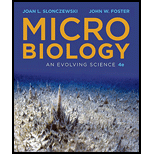
Microbiology: An Evolving Science (Fourth Edition)
4th Edition
ISBN: 9780393615098
Author: John W. Foster, Joan L. Slonczewski
Publisher: W. W. Norton & Company
expand_more
expand_more
format_list_bulleted
Question
Chapter 26.7, Problem 2TQ
Summary Introduction
To review:
The therapy for tetanus.
Introduction:
Tetanus is a disease caused by an anaerobic gram-positive spore-forming bacteria, Clostridium tetani. It is also known as lockjaw. Tetanus involves constant and involuntary contraction of muscles. It results in paralysis, blockage of arteries in the lungs and even death in severe cases. The spasm produced during contraction can also fracture the vertebrate of the human body.
Expert Solution & Answer
Want to see the full answer?
Check out a sample textbook solution
Students have asked these similar questions
Based on your results from the Mannitol Salt Agar (MSA) media, which of your bacteria were mannitol fermenters and which were not mannitol fermenters?
help tutor please
Q8. A researcher wants to study the effectiveness of a pill intended to reduce stomach heartburn in pregnant
women. The researcher chooses randomly 400 women to participate in this experiment for 9 months of their
pregnancy period. They all need to have the same diet. The researcher designs two groups of 200 participants:
One group take the real medication intended to reduce heartburn, while the other group take placebo
medication. In this study what are:
Independent variable:
Dependent variable:
Control variable:
Experimental group: "
Control group:
If the participants do not know who is consuming the real pills and who is consuming the sugar pills.
This study is
It happens that 40% of the participants do not find the treatment helpful and drop out after 6 months.
The researcher throws out the data from subjects that drop out. What type of bias is there in this study?
If the company who makes the medication funds this research, what type of bias might exist in this
research work?
Chapter 26 Solutions
Microbiology: An Evolving Science (Fourth Edition)
Ch. 26.2 - Prob. 1TQCh. 26.2 - Prob. 2TQCh. 26.3 - Prob. 1TQCh. 26.5 - Prob. 1TQCh. 26.5 - Prob. 2TQCh. 26.5 - Prob. 3TQCh. 26.5 - Prob. 4TQCh. 26.6 - Prob. 1TQCh. 26.7 - Prob. 1TQCh. 26.7 - Prob. 2TQ
Ch. 26.7 - Prob. 3TQCh. 26.7 - Prob. 4TQCh. 26.7 - Prob. 5TQCh. 26 - Prob. 1RQCh. 26 - Prob. 2RQCh. 26 - Prob. 3RQCh. 26 - Prob. 4RQCh. 26 - Prob. 5RQCh. 26 - Prob. 6RQCh. 26 - Prob. 7RQCh. 26 - Prob. 8RQCh. 26 - Prob. 9RQCh. 26 - Prob. 10RQCh. 26 - Prob. 11RQCh. 26 - Prob. 12RQCh. 26 - Prob. 13RQCh. 26 - Prob. 14RQCh. 26 - Prob. 15RQCh. 26 - Prob. 16RQCh. 26 - Prob. 17RQCh. 26 - Prob. 18RQCh. 26 - Prob. 19RQCh. 26 - Prob. 20RQCh. 26 - Prob. 21RQCh. 26 - Prob. 22RQCh. 26 - Prob. 23RQCh. 26 - Prob. 24RQCh. 26 - Prob. 1TQCh. 26 - Prob. 2TQCh. 26 - Prob. 3TQCh. 26 - Prob. 4TQ
Knowledge Booster
Learn more about
Need a deep-dive on the concept behind this application? Look no further. Learn more about this topic, biology and related others by exploring similar questions and additional content below.Similar questions
- What is behavioral adaptarrow_forward22. Which of the following mutant proteins is expected to have a dominant negative effect when over- expressed in normal cells? a. mutant PI3-kinase that lacks the SH2 domain but retains the kinase function b. mutant Grb2 protein that cannot bind to RTK c. mutant RTK that lacks the extracellular domain d. mutant PDK that has the PH domain but lost the kinase function e. all of the abovearrow_forwardWhat is the label ?arrow_forward
- Can you described the image? Can you explain the question as well their answer and how to get to an answer to an problem like this?arrow_forwardglg 112 mid unit assignment Identifying melting processesarrow_forwardGive only the mode of inheritance consistent with all three pedigrees and only two reasons that support this, nothing more, (it shouldn't take too long)arrow_forward
- Oarrow_forwardDescribe the principle of homeostasis.arrow_forwardExplain how the hormones of the glands listed below travel around the body to target organs and tissues : Pituitary gland Hypothalamus Thyroid Parathyroid Adrenal Pineal Pancreas(islets of langerhans) Gonads (testes and ovaries) Placentaarrow_forward
arrow_back_ios
SEE MORE QUESTIONS
arrow_forward_ios
Recommended textbooks for you
 Medical Terminology for Health Professions, Spira...Health & NutritionISBN:9781305634350Author:Ann Ehrlich, Carol L. Schroeder, Laura Ehrlich, Katrina A. SchroederPublisher:Cengage LearningEssentials of Pharmacology for Health ProfessionsNursingISBN:9781305441620Author:WOODROWPublisher:Cengage
Medical Terminology for Health Professions, Spira...Health & NutritionISBN:9781305634350Author:Ann Ehrlich, Carol L. Schroeder, Laura Ehrlich, Katrina A. SchroederPublisher:Cengage LearningEssentials of Pharmacology for Health ProfessionsNursingISBN:9781305441620Author:WOODROWPublisher:Cengage- Surgical Tech For Surgical Tech Pos CareHealth & NutritionISBN:9781337648868Author:AssociationPublisher:CengageUnderstanding Health Insurance: A Guide to Billin...Health & NutritionISBN:9781337679480Author:GREENPublisher:Cengage


Medical Terminology for Health Professions, Spira...
Health & Nutrition
ISBN:9781305634350
Author:Ann Ehrlich, Carol L. Schroeder, Laura Ehrlich, Katrina A. Schroeder
Publisher:Cengage Learning

Essentials of Pharmacology for Health Professions
Nursing
ISBN:9781305441620
Author:WOODROW
Publisher:Cengage

Surgical Tech For Surgical Tech Pos Care
Health & Nutrition
ISBN:9781337648868
Author:Association
Publisher:Cengage

Understanding Health Insurance: A Guide to Billin...
Health & Nutrition
ISBN:9781337679480
Author:GREEN
Publisher:Cengage

Animal Communication | Ecology & Environment | Biology | FuseSchool; Author: FuseSchool - Global Education;https://www.youtube.com/watch?v=LsMbn3b1Bis;License: Standard Youtube License